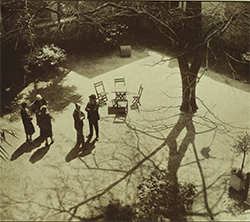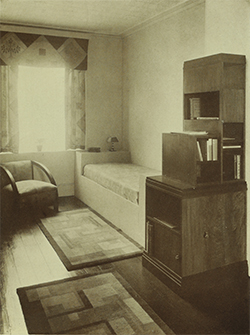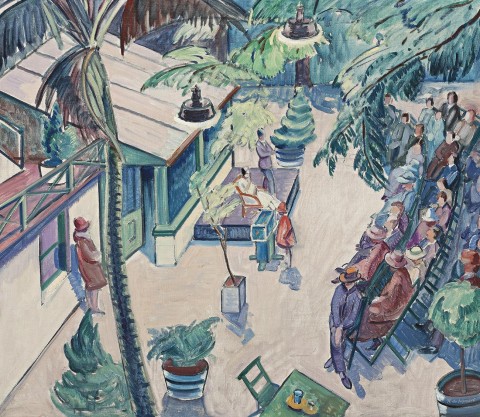THE MEETING IN THE GARDEN, c.1929
ROY DE MAISTRE
oil on canvas
67.0 x 76.5 cm
signed lower right: R de Mestre
bears inscription verso: 29
Collection of the artist, on long term loan to S.A. Parker Frames, Sydney until c.1960
Private collection
Deutscher Fine Art, Melbourne
Ken and Joan Plomley Collection of Modernist Art, Melbourne, acquired from the above in April 1986
A Group of Seven Exhibition, Macquarie Galleries, Sydney, 26 March – 5 April 1930, cat. 29
Contemporary Group Exhibition, Farmer’s Blaxland Gallery, Sydney, 14 – 25 August 1934, cat. 29 (as ‘Meeting in the Courtyard, Burdekin House’)
Australian Art: Colonial to Modern, Deutscher Fine Art, Melbourne, 9 – 25 April 1986, cat. 90 (illus. in exhibition catalogue)
‘Art Exhibition at Macquarie Galleries’, Sydney Morning Herald, Sydney, 26 March 1930, p. 13
Tildesley, B., ‘Art Notes’, Sydney Mail, Sydney, 9 April 1930, p. 28
‘A Group of Seven Exhibition’, Art in Australia, Sydney, third series, no. 32, June – July 1930, pl. 21 (illus.)
Johnson, H., Roy de Maistre: The Australian Years 1894-1930, Craftsman House, Sydney, 1988, pl. 37, pp. 2 (illus.), 77, 122
190101 - Supplementary Image.jpg

MRS GEORGE VIVARS, MRS CHARLES WALKER
BURDEKIN HOUSE, 1929
Canberra
The Meeting in the Garden, c.1929, is one of the most significant Australian paintings by Roy de Maistre ever to appear on the market. Not only is it a record of events at the ground-breaking Burdekin House Exhibition, it is also an exemplar of the vanguard of modernist technique as practiced in Australia at the end of the 1920s. Since returning to Australia from Europe in 1926, de Maistre had involved himself in a wide variety of art and design activities, including a collaboration with the noted photographer Harold Cazneaux on a series of influential high-society portraits for The Home magazine. The exhibition at Burdekin House marked the culmination of these activities and was de Maistre’s final modernist gesture in his home country before leaving permanently for London in March 1930.
Burdekin House was a grand colonial mansion built in 1841 opposite Parliament House in Macquarie Street, Sydney. In 1924 the house was sold to T. E. Rofe, a prominent local businessman and philanthropist, and through him, the rear courtyard and the central spaces on the ground floor were given over to the Royal Prince Alfred Hospital Ladies' Auxiliary for fund-raising events. The upstairs rooms were let as studios for artists and the residence subsequently earned a reputation for being ‘the centre of so much society and politics of the town’.1 Shortly after his return from Europe,2 De Maistre moved into ‘a large room on the first floor … (b)ed in one corner, screen with a table (‘Kitchen’), no sink and just a ‘loo on the turn of the stairs … the rest of the room was his studio, easels, plants, folds of stuff, jars of dried flowers, pots and pots of paintbrushes’.3 The idea of an art-and-design fundraiser for the Hospital had its genesis in conversations between de Maistre, John D. Moore, Basil Burdett and Thea Proctor; and De Maistre was photographed by Cazneaux in the courtyard discussing preparations for the exhibition with prominent society figures including Mrs. Rodney Dangar and Mr. T. H. Kelly.4 Whilst the lower levels were to be filled with antiquities loaned from wealthy patrons such as these, the top floor became the truly revolutionary project, a series of rooms designed by leading modernist practitioners. Here, de Maistre designed a man’s study,5 an austere room featuring modern French rugs, armchair, recessed bed, Russian patch-work curtains and a ‘skyscraper’ bookcase interpreted from a design by the American Paul Frankl. Paintings by de Maistre also decorated the walls of Hera Roberts’ dining room and Professor A. L. Sadler’s living room.6
190101 (2) - Supplementary Image.jpg

Burdekin House Exhibition
Canberra
Opening on 8 October 1929, the three-month exhibition lived up to its promise ‘to be the greatest of its kind [ever] held in Australia’,7 and became an active symposium into the benefits of a modernist vision. Associated lectures and events were held in the rear courtyard, one of which is the subject of The Meeting in the Garden.8 Viewed from the upper balcony outside de Maistre’s studio, a group sits listening to a speaker under the canopy of the courtyard’s cabbage-tree palms and honey locust tree. De Maistre’s compositional design draws the eye around the canvas through the serried rows of the seated audience and the animated brush marks of the green and caramel passages, all anchored at the centre by the vivid red of the girl’s dress and the armchair on the stage.9 Given the subsequent demolition of Burdekin House, The Meeting in the Garden exists not only as an important statement by the country’s leading modernist artist, but also as a significant painterly record of Sydney’s historic past.
1. ‘Sydney S’Amuse’, The Home: an Australian journal of quality, Ure Smith, Sydney, vol. 7, no. 1, January 1926, p. 40
2. Burdekin House first given as the artist’s address in 1926 when he signed the Government House Visitors Book, 20 May 1926 (‘Roi de Mestre, Burdekin House, Macquarie Street). See Johnson, H., Roy de Maistre: The Australian Years 1894-1930, Craftsman House, Sydney, 1988, p. 90. He changed the spelling of his name to ‘Roy de Maistre’ from late 1930.
3. Foott, B., 1986, quoted in Johnson, H., The Sydney art patronage system, 1890 – 1940, Bungoona Technologies, New South Wales, 1997, pp. 151, 152. Other artist residents included Frank Weitzel and Adrian Feint, Aletta Lewis, Lorna Nimmo and the future ‘street poet’ Bea Miles.
4. See ‘Spring Sunlight’, The Home: the Australian journal of quality, vol. 10, no. 11, 1 November 1929, p. 36
5. De Maistre also acted as the exhibition’s convener and manager. The other room designers were Adrian Feint, Frank Wenzel, Hera Roberts, and Prof. A. L. Sadler.
6. In Prof. Sadler’s room was de Maistre’s painting Harbour Entrance, St Jean de Luz 1926, whilst Roberts’ room featured a larger re-working of lot 5 Bridge in Spain (Alcantara Bridge, Toledo), 1926.
7. ‘Art Notes’, The Home: the Australian journal of quality, Ure Smith, Sydney, vol. 10, no. 10, 1 October 1929, p. 102
8. In December, de Maistre provided the design for a production by Dora Wilcox performed in the courtyard and titled “At ‘Waratah’ in the early ‘Fifties”. See ‘Art Notes’, The Home: the Australian journal of quality, Ure Smith, Sydney, vol. 10, no. 12, 2 December 1929, p. 15
9. Burdekin House was demolished for a new St Stephen's Presbyterian Church to replace the existing one in Phillip Street, itself demolished for the extension of Martin Place.
ANDREW GAYNOR
